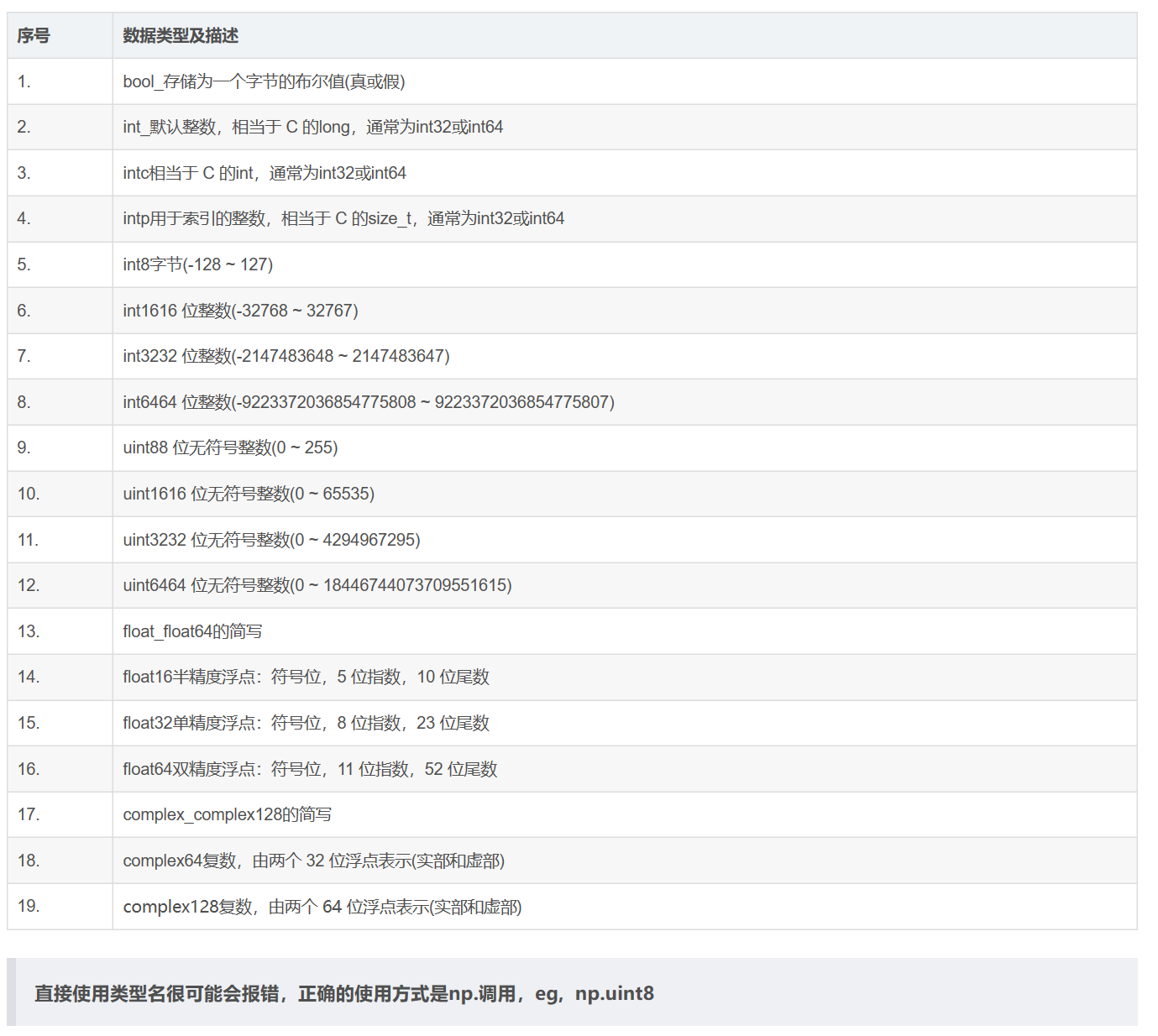1.数据类型简介
Numpy
NumPy 支持比 Python 更多种类的数值类型。 下表显示了 NumPy 中定义的不同标量数据类型。

Pytorch
Torch定义了七种CPU张量类型和八种GPU张量类型,这里我们就只讲解一下CPU中的,其实GPU中只是中间加一个cuda即可,如torch.cuda.FloatTensor:
- torch.FloatTensor(2,3) 构建一个2*3 Float类型的张量
- torch.DoubleTensor(2,3) 构建一个2*3 Double类型的张量
- torch.ByteTensor(2,3) 构建一个2*3 Byte类型的张量
- torch.CharTensor(2,3) 构建一个2*3 Char类型的张量
- torch.ShortTensor(2,3) 构建一个2*3 Short类型的张量
- torch.IntTensor(2,3) 构建一个2*3 Int类型的张量
- torch.LongTensor(2,3) 构建一个2*3 Long类型的张量
同样,直接使用类型名很可能会报错,正确的使用方式是torch.调用,eg,torch.FloatTensor()
2.Python的type()函数
type函数可以由变量调用,或者把变量作为参数传入。
返回的是该变量的类型,而非数据类型。
data = np.random.randint(0, 255, 300) print(type(data)) # <class 'numpy.ndarray'>
3.Numpy/Pytorch的dtype属性
返回值为变量的数据类型
t_out = torch.Tensor(1,2,3) print(t_out.dtype) # torch.float32 t_out = torch.Tensor(1,2,3) print(t_out.numpy().dtype) # float32
4.Numpy中的类型转换
n_out = n_out.astype(np.uint8) # 由变量调用,但是直接调用不会改变原变量的数据类型,是返回值是改变类型后的新变量,所以要赋值回去。
#初始化随机数种子 np.random.seed(0) data = np.random.randint(0, 255, 300) print(data.dtype) n_out = data.reshape(10,10,3) #强制类型转换 n_out = n_out.astype(np.uint8) print(n_out.dtype) img = transforms.ToPILImage()(n_out) img.show()
Pytorch中的类型转换
pytorch中没有astype函数,正确的转换方法是
1.变量直接调用类型
tensor = torch.Tensor(3, 5) # torch.long() 将tensor投射为long类型 newtensor = tensor.long() # torch.half()将tensor投射为半精度浮点类型 newtensor = tensor.half() # torch.int()将该tensor投射为int类型 newtensor = tensor.int() # torch.double()将该tensor投射为double类型 newtensor = tensor.double() # torch.float()将该tensor投射为float类型 newtensor = tensor.float() # torch.char()将该tensor投射为char类型 newtensor = tensor.char() # torch.byte()将该tensor投射为byte类型 newtensor = tensor.byte() # torch.short()将该tensor投射为short类型 newtensor = tensor.short() # 同样,和numpy中的astype函数一样,是返回值才是改变类型后的结果,调用的变量类型不变
2.变量直接调用pytorch中的type函数
type(new_type=None, async=False)如果未提供new_type,则返回类型,否则将此对象转换为指定的类型。 如果已经是正确的类型,则不会执行且返回原对象。
用法如下:
t = torch.LongTensor(3, 5)
t = t.type(torch.FloatTensor)
3.变量调用pytorch中的type_as函数
如果张量已经是正确的类型,则不会执行操作。具体操作方法如下:
t = torch.Tensor(3,5) tensor = torch.IntTensor(2, 3) t = t.type_as(tensor)
——————————
版权声明:本文为CSDN博主「啧啧啧biubiu」的原创文章,遵循 CC 4.0 BY-SA 版权协议,转载请附上原文出处链接及本声明。
原文链接:https://blog.csdn.net/qq_37385726/article/details/81774150